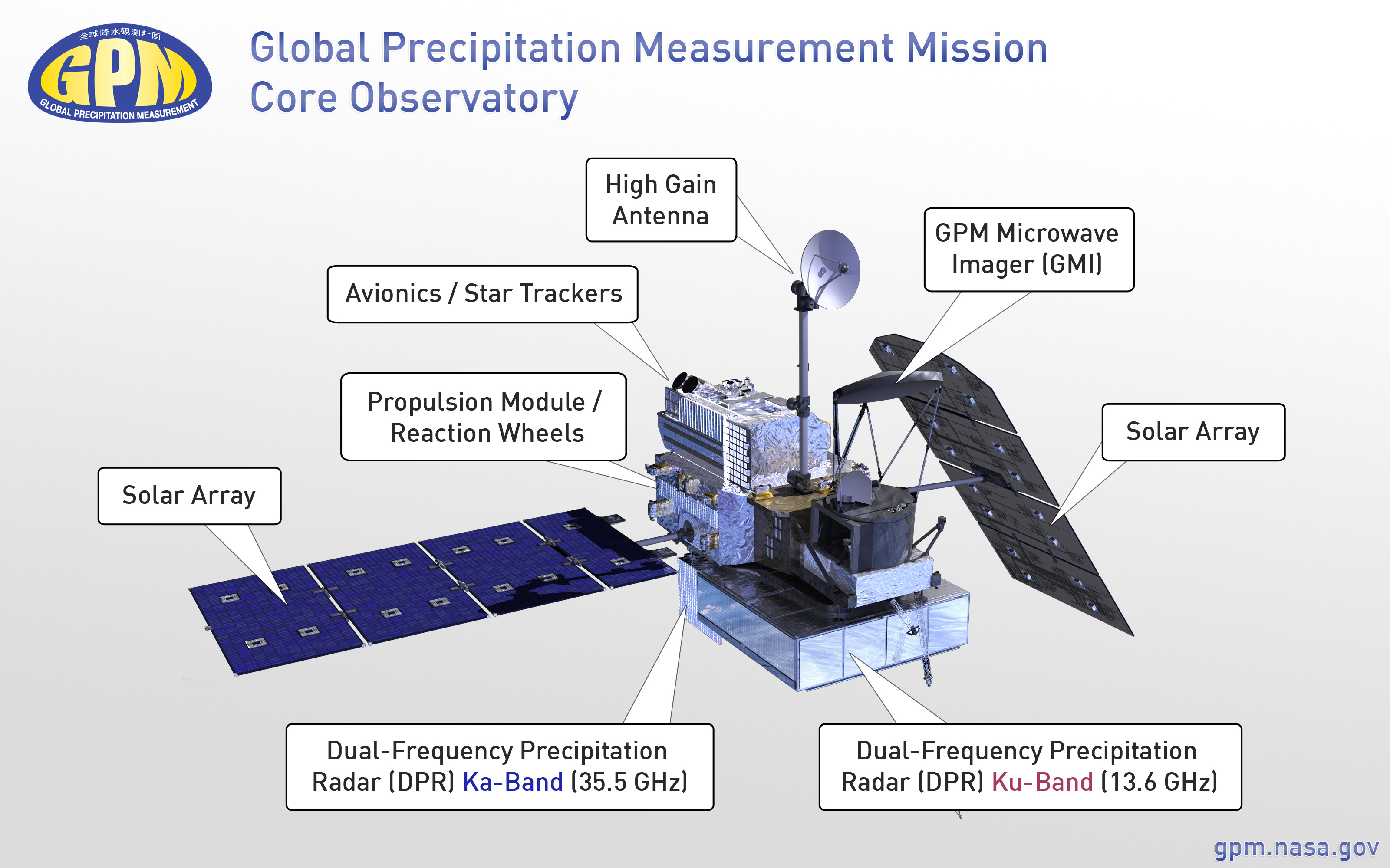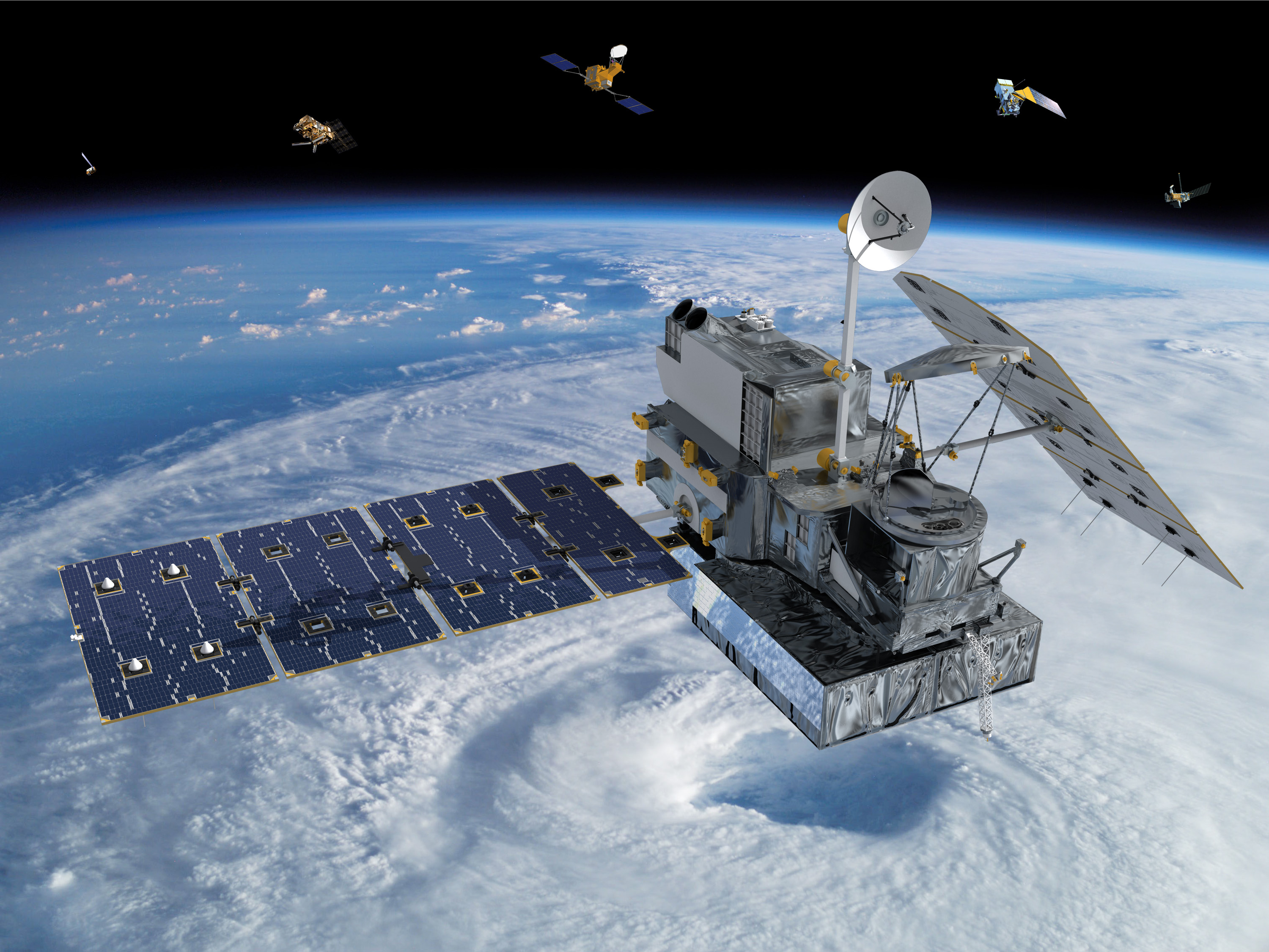Rain, storms and snow. Well if not for their existence the English may be left with nothing to talk about - then again we probably would not exist (at least on this planet). Yet these atmospheric turbulence are rather difficult to study in detail from the ground - even with Doppler radar and weather balloons, investigation of such storm systems in three dimensions is limited to certain point readings and up to a certain height.
Luckily satellites have provided the vital link for weather systems monitoring, and the series of satellites are becoming more specialized in the investigation of various features of meteorology. The science of precipitation is no exception, and today we are seeing the most advanced satellite made for mapping precipitation - built jointly by NASA's Goddard Space Flight Center and JAXA - launching into space, replacing its 16 year old predecessor as the core spacecraft for rain and snow profile measurements.

Launch window:|18:37-19:37 UTC, February 27, 2014 / 1:37-2:37 p.m. EST / 03:37-04:37 JST, February 28, 2014
Launch site:|Pad 1, Yoshinobu Launch Complex, Tanegashima Space Center, Japan
{colsp=2}
[highlight]L[eventtimer]2014-02-27 18:37:00;%c%%ddd%/%hh%:%mm%:%ss%[/eventtimer][/highlight]
Payload:The
Global Precipitation Measurement (GPM) mission is an international network of satellites that provide the next-generation global observations of rain and snow. Building upon the success of the Tropical Rainfall Measuring Mission (TRMM), the GPM concept centers on the deployment of a “Core” satellite carrying an advanced radar / radiometer system to measure precipitation from space and serve as a reference standard to unify precipitation measurements from a constellation of research and operational satellites. Through improved measurements of precipitation globally, the GPM mission will help to advance our understanding of Earth's water and energy cycle, improve forecasting of extreme events that cause natural hazards and disasters, and extend current capabilities in using accurate and timely information of precipitation to directly benefit society. GPM, initiated by NASA and the Japan Aerospace Exploration Agency (JAXA) as a global successor to TRMM, comprises a consortium of international space agencies, including the Centre National d’Études Spatiales (CNES), the Indian Space Research Organization (ISRO), the National Oceanic and Atmospheric Administration (NOAA), the European Organization for the Exploitation of Meteorological Satellites (EUMETSAT), and others. The GPM Core Observatory is scheduled for launch in early 2014.
Building upon TRMM’s Legacy
The Tropical Rainfall Measuring Mission (TRMM), launched by NASA and JAXA in 1997, uses both active and passive microwave instruments to measure rainfall in the tropics. It also provides a foundation for merging rainfall information from other satellites. TRMM has shown the importance of taking observations from a non-Sun-synchronous orbit at different times of the day, between observations by polar orbiting sensors at fixed times of the day, to improve near real-time monitoring of hurricanes and accurate estimation of time-accumulation of rain volume. The GPM Core Observatory will continue this sampling from a non-Sun-synchronous orbit and extend coverage to higher latitudes to provide a global view of precipitation.
The GPM Core Observatory design is an extension of TRMM’s highly successful rain-sensing package, which focused primarily on heavy to moderate rain over tropical and subtropical oceans. Since light rain and falling snow account for significant fractions of precipitation occurrences in middle and high latitudes, a key advancement of GPM over TRMM is the extended capability to measure light rain (< 0.5 mm hr-1), solid precipitation and the microphysical properties of precipitating particles. This capability drives the designs of both the active and passive microwave instruments on GPM. The Core Observatory will then act as a reference standard for the precipitation estimates acquired by the GPM constellation of sensors.
GPM Core Observatory
The GPM Core Observatory will carry the first space-borne Ku/Ka-band Dual-frequency Precipitation Radar (DPR) and a multi-channel GPM Microwave Imager (GMI). The DPR instrument, which will provide three dimensional measurements of precipitation structure over 78 and 152 mile (125 and 245 km) swaths, consists of a Ka-band precipitation radar (KaPR) operating at 35.5 GHz and a Ku-band precipitation radar (KuPR) operating at 13.6 GHz. Relative to the TRMM precipitation radar, the DPR is more sensitive to light rain rates and snowfall. In addition, simultaneous measurements by the overlapping of Ka/Ku-bands of the DPR can provide new information on particle drop size distributions over moderate precipitation intensities. In addition, by providing new microphysical measurements from the DPR to complement cloud and aerosol observations, GPM is expected to provide further insights into how precipitation processes may be affected by human activities.
The GMI instrument is a conical-scanning multi-channel microwave radiometer covering a swath of 550 miles (885 km) with thirteen channels ranging in frequency from 10 GHz to 183 GHz. The GMI uses a set of frequencies that have been optimized over the past two decades to retrieve heavy, moderate and light precipitation using the polarization difference at each channel as an indicator of the optical thickness and water content.
GPM Science and Applications
GPM will provide global precipitation measurements with improved accuracy, coverage and dynamic range for studying precipitation characteristics. GPM is also expected to improve weather and precipitation forecasts through assimilation of instantaneous precipitation information. Relative to TRMM, the enhanced measurement and sampling capabilities of GPM will offer many advanced science contributions and societal benefits:
* Improved knowledge of the Earth’s water cycle and its link to climate change
* New insights into storm structures and large-scale atmospheric processes
* New insights into precipitation microphysics
* Advanced understanding of climate sensitivity and feedback processes
* Extended capabilities in monitoring and predicting hurricanes and other extreme weather events
* Improved forecasting abilities for natural hazards, including floods, droughts and landslides.
* Enhanced numerical prediction skills
* Improved agricultural crop forecasting and monitoring of freshwater resources
{colsp=2}Characteristics
Mass:
|
Power:
|
Lifetime:
|
Orbit:
|
Inclination:
|
In addition 7 cubesats from various Japanese institutions are carried on this flight. (more on that later)
Launch Vehicle:The 23rd flight of the H-IIA Launch Vehicle (H-IIA F23) is an "H2A202" type with two solid rocket boosters (SRB-As) attached. The 4S (4 m in diameter) type fairing is used.
Live coverage of the launch:
Links:
Launch Sequence:
{colsp=2}
Event
|
Time [mm:ss]
|
Altitude [km]
|
Inertial speed [km/s]
1.
|Liftoff|
0:00
|
0
|
0.4
2.
|Solid rocket booster burnout*|
1:39
|
47
|
1.5
3.
|Solid rocket booster jettison**|
1:48
|
55
|
1.5
4.
|Payload fairing jettison|
4:05
|
148
|
2.5
5.
|1st stage engine (main engine) cutoff (MECO)|
6:36
|
230
|
5.0
6.
|1st and 2nd stages separation|
6:44
|
236
|
5.0
7.
|2nd stage ignition (SEIG)|
6:50
|
239
|
5.0
8.
|2nd stage engine cutoff (SECO)|
14:58
|
399
|
7.7
9.
|GPM-Core separation|
15:49
|
398
|
7.7
10.
|ShindaiSat cubesat separation|
24:09
|
400
|
7.7
11.
|STARS-Ⅱcubesat separation|
28:19
|
403
|
7.7
12.
|TeikyoSat-3 cubesat separation|
32:29
|
406
|
7.7
13.
|ITF-1 cubesat separation|
36:39
|
408
|
7.7
14.
|OPUSAT cubesat separation|
37:59
|
408
|
7.7
15.
|INVADER cubesat separation|
39:19
|
408
|
7.7
16.
|KSAT2 cubesat separation|
40:39
|
408
|
7.7
*) Moment of combustion pressure reaching 2% of maximum
**) Thrust strut cutoff

The current view on Tanegashima Space Center (webcam). *
* This picture is automatically updated at intervals.
You need to reload the page to see the latest image.











